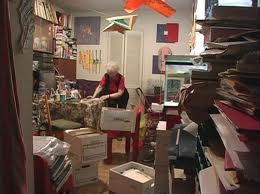previous
Good advice about how to de-clutter
starting exploration
Thoughts and questions related to the essay “Edna’s List”
- Attached to the essay "Edna’s List"
Where does collecting end and hoarding begin?
Posted December 5, 2011 10:57 amI think Dr. Zasio (author of “The Hoarder in You”) would acknowledge that even when a collection takes over a home, it doesn’t slip into stockpiling if looked upon and protected as something valuable. Take, for example, the art collection of the Vogels, who amassed some 4700 works of art, which they stored in their small Manhattan apartment.  They stuffed prints into every available place, including under their bed, which got higher and higher as the years passed. Eventually, they donated the collection to the National Gallery of Art in D.C., though they continue to visit the galleries and artists’ studios and to buy, buy, buy. (More about the not-to-be-missed movie about them, Herb and Dorothy.)
They stuffed prints into every available place, including under their bed, which got higher and higher as the years passed. Eventually, they donated the collection to the National Gallery of Art in D.C., though they continue to visit the galleries and artists’ studios and to buy, buy, buy. (More about the not-to-be-missed movie about them, Herb and Dorothy.)
But what if the things you collect are not in themselves valuable? I have friends who collect a variety of inexpensive, small objects—what you might call tchotchkes—that they arrange by size, color, typography, shape, etc., and which covers most of the flat surfaces in their house. Their home is an art installation; stepping into it feels like entering a Van Gogh painting. Someone might see this as an example of the collection taking over the house, but I’d argue that that is the whole point.
Words can’t do its beauty justice; my friends have obliged with some photos.
topics: art
share
 site feed
site feed
Beauty in clutter
There is actually a name for this: horror vacui. It's an art style in which every inch of blank space is filled and dates back ...





eliz March 7, 2012 at 5:08 pm
I read the article and it is indeed fascinating, a rift on keeping on living, through our stuff. I especially love what she writes about a company that rents storage facilities for the stuff that you don’t want to discard but can’t fit in your house:
“Public Storage™ claims to be the largest self-storage company in the world, with over 2000 facilities in the U.S. that together accumulate “approximately 129 million net rentable square feet” according to their website. The company started in 1972 in Southern California, ever the harbinger of things to come: 58,000 storage facilities around the world by 2009, of which 46,000 are located in the United States. Still the leader in the industry it virtually invented, Public Storage™ accounts for its success like this:
What we didn’t realize at the time [in 1972] is that we’re entering a business at the front of a massive power curve composed of three elements. One, the amount of living space per capita was going down. Two, every year that goes by, there’s more stuff. Last year’s stuff, next year’s stuff. And next year there’ll be another year of accumulating stuff. The third element is one of human nature — people are squirrels. Combine these three and Bam! The need for places to keep all this stuff. Stuff takes on a life of its own. “It was Grandma’s. It was my baby’s. I simply can’t throw it away.”
The association made here between “human nature” and squirrel-like behavior reinforces the idea that accumulation is animalistic, instinctive, which means there’s no fighting it, like death and taxes. Indeed, something like death and taxes are the other two elements identified in the “massive power curve” that the company rode to success as if in some surfer’s wet dream. First, it’s just a question of time: given that squirrel-like accumulation is natural, “every year that goes by, there’s more stuff.” And stuff “takes on a life of its own.” This stuff-ly life is, however, a kind of haunting by the dead and the past: Grandma has died and the baby has grown up. As for taxes, they are indexed and implied by the measure of “living space per capita,” which in 1972 could be projected to continue on a downward trend.
So you have living space and storage space: less of the former means more of the latter. Like Storage Wars, this canny business plan evolves from a contemporary storage culture that is (paradoxically?) a culture of scarcity. There is a scarcity of living space, of space for some life — yours, mine, his, hers — to keep living. As if along with every storage facility there had necessarily to be a homeless encampment. Along with it, which is to say also within it, in those lockers where effects and remainders of homelessness are able still to put a roof over their head, paying rent that is cheaper than anywhere else. Storage “facilities” house many who are homeless without giving them a home or an address, without granting them living space (or facilities), just storage space: a unit, as it’s called.
What is shown, then, is the reverse side of capitalist accumulation, the side where things don’t really accumulate so much as pile up: stuff you can’t throw away, stuff that is incommensurable with commodities for a little while yet. The things stored by those units have accumulated as the immeasurable fragments of life, both the life of someone who is, or used to be, living somewhere and this uncanny life of its own that stuff can take on.”
It goes on and on. Quite brilliant. Worth reading, and rereading.
Darien February 12, 2012 at 4:51 pm
Here’s a fascinating article I just came across about the origins of accumulation, from the Los Angeles Review of Books. An interesting perspective on this subject:
http://lareviewofbooks.org/post/17038605488/life-in-storage